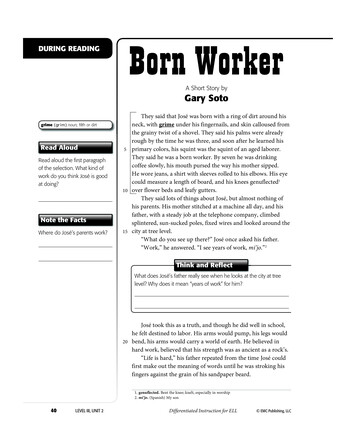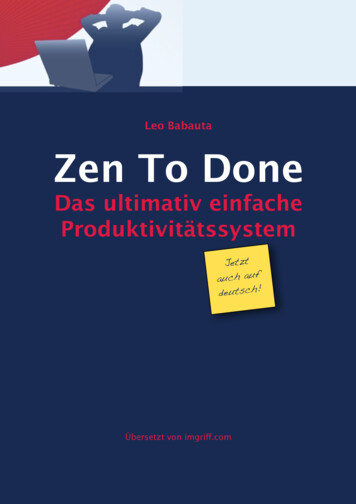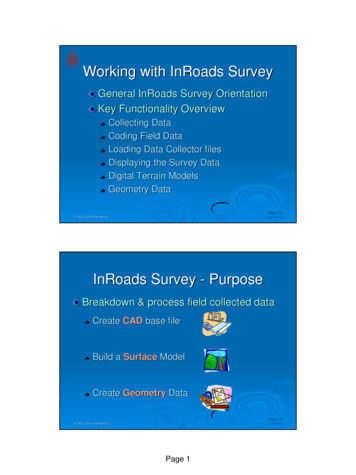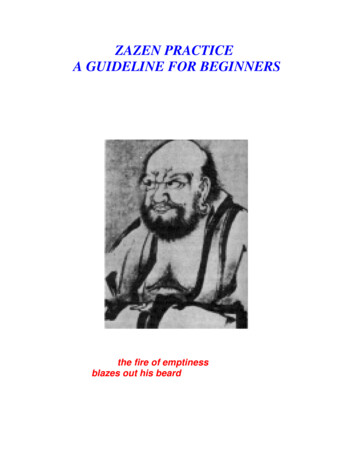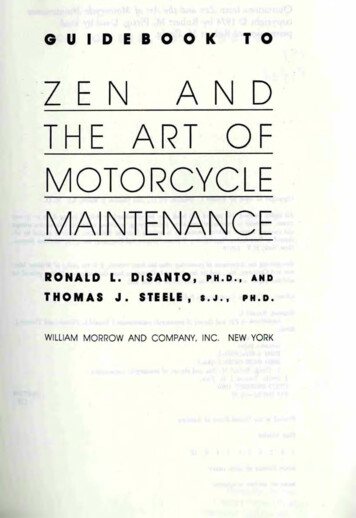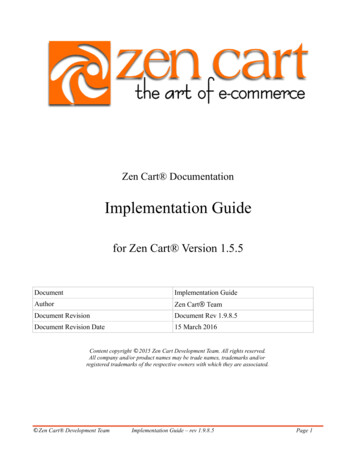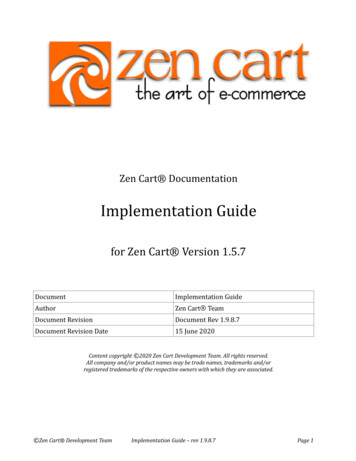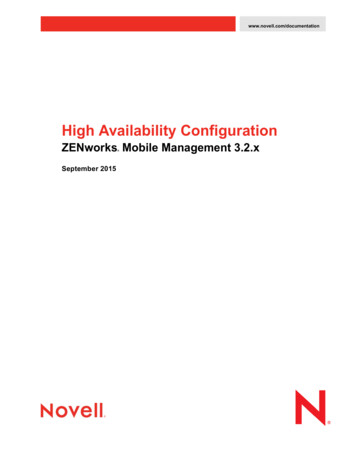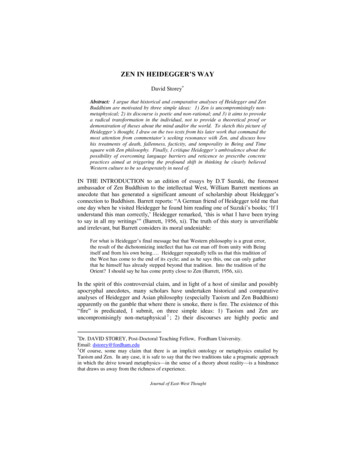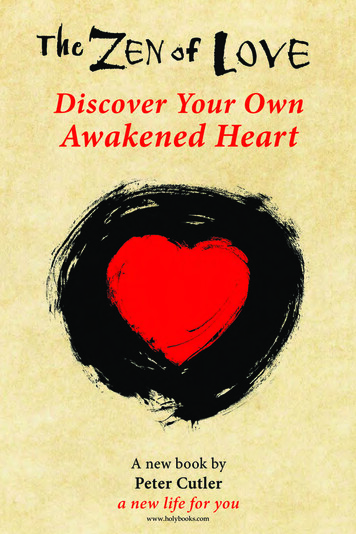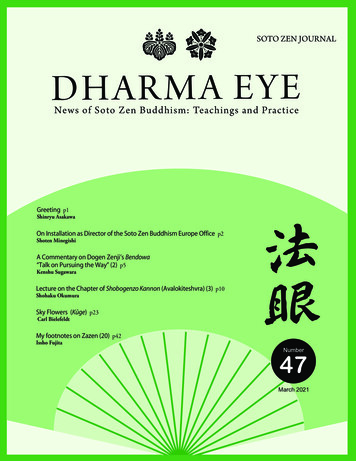
Transcription
SOTO ZEN JOURNALDH AR MA EYENews of Soto Zen Buddhism: Teachings and PracticeGreeting p1Shinryu AsakawaOn Installation as Director of the Soto Zen Buddhism Europe Office p2Shoten MinegishiA Commentary on Dogen Zenji’s Bendowa“Talk on Pursuing the Way” (2) p5Kenshu SugawaraLecture on the Chapter of Shobogenzo Kannon (Avalokiteshvra) (3) p10Shohaku OkumuraSky Flowers (Kuge)p23Carl BielefeldtMy footnotes on Zazen (20) p42Issho FujitaNumber47March 2021
earnestly think about how we will meet theseA Greetingfuture challenges.Rev. Shinryu AsakawaFrom 1992 onwards, when the Soto sectDirector of the Division of Education andDisseminationSotoshu Shumuchoadopted the slogan “Human rights, Peace, andthe Environment” which is in line with sustainable development goals (SDGs), we have beensearching for a practical and concrete way totake a new step forward.To all of you who read Dharma Eye, I wouldlike to thank you for your support. I hope youare doing well. I would also like to thank you forIn particular with regard to the fifth goal ofyour continued love for the Dharma. My name isSDGs – “Achieving Gender Equality” – there areShinryu Asakawa. I was appointed as the Direc-more female Soto priests outside Japan than intor of the Division of Education and Dissemina-Japan. The Soto Zen Buddhism Internationaltion on October 21, 2020. Taking on the heavyCenter is the only Soto sect organ where, in theresponsibility of teaching activities and educa-ratio between men and women, there are moretion, which for me is the basis of Soto Zen, is awomen on the staff than men. For this reason,sobering thought. I humbly thank you for yourthis office is a valuable institution for gendercontinued guidance and love for the Dharma.equality efforts in the Soto sect. My hope is thatthese overseas efforts for gender equality willfrom now on be delivered to Japan.On March 11, 202, the World Health Organization announced a “Pandemic Declaration” dueNext year, in 2022, Soto Zen in Northto the spread of the novel coronavirus infection.America will celebrate its 100th anniversary.The harm caused by the spread of this infectioncontinues now even after a year has passed.More than 2,750,000 precious lives have beenIn 1922, Rev. Hosen Isobe, Director of Sotolost. I would like to express from the bottom ofZen in Hawaii (Hawaii Kaikyo Sokan) at thatmy heart condolences for those who havetime, was requested by Hioki Mokuzen Zenjipassed away as well as my deepest sympathy toand Arai Sekizen Zenji to go to Los Angeles,all family members and those related to peopleCalifornia. There, he met Toyokichi Nagasaki.have been infected by this virus.This meeting was the opportunity through with“Zenshuji Temporary Church” was openedWe are now in a pandemic. In addition,when they leased the second floor of Mr.climate change due to global warming and soNagasaki’s home. Later, as the number of believ-forth are challenges that are piling up. We, theers gradually increased, this space became toopriests of the Soto sect, have aroused the Way-small. Consequently, Mr. Nagasaki opened upseeking mind and as one monk or nun who hashis whole house so Zenshuji could use it. Afterreceived the bodhisattva precepts, we mustrepeated renovations, the current building of1
On Installation as Director ofthe Soto Zen BuddhismEurope OfficeRyodai Honzan Betsuin Zenshuji took shape.Later, in the 1960s, as the younger generation came to play a central role, a movement toRev. Shoten MinegishiDirector of Soto Zen BuddhismEurope Officecreate a new society arose called the “counterculture.” Many of these younger people wereattracted to the teaching of knowing one’s trueself though the practice of shikantaza or justsitting. Through the guidance of Zen teachers,Meeting people in Europe who are earnestlythey began to practice Zen, and this led to thepracticing Zen, I once again feel the universaldevelopment of Zen centers as Soto Zen spreadattraction to zazen. It seems that first of thethroughout the country. As these Zen centersfeatures of zazen is harmonizing the mind byand Zen Groups spread through all parts ofmeans of the body. No matter how much youNorth America, an emphasis was put on sittingmay have studied about zazen, that is not zazen.in zazen and the members of these placesThrough the body, by the body, there is some-worked hard at their daily practice.thing that we could get through physical practiceof zazen.In this way, Soto Zen has become one movement that has spread across the great land ofThe second thing I’ve noticed is that it is notAmerica. Walking together, this is the first steppossible to practice zazen if you do not believein creating the future. We look forward to thein it and this is something that doesn’t necessar-100th anniversary celebrations of North Americaily appear at the beginning of practice. Anyoneinternational teaching activities.can sit in zazen. if they have a body. It does notdiscriminate on the basis of a person’s back-I pray, of course, for the success of the eventsground, knowledge, upbringing, status, ethnic-next year for the 100th anniversary in Northity, or culture. Zazen is something experiencedAmerica and for the further development ofwith the body – that’s it. I think that in zazeninternational teaching activities there. I wouldthere is a universality that accompanies thelike to conclude this greeting by asking for yourbody, and, in that universality, there is also thecontinued cooperation and love for the Dharma.potential to open up a new symbiotic horizon.Thirdly, in connection with using the bodyto harmonize the mind, there is the refinedmanner of the Soto school. “A dignified manneris the Buddhadharma; decorum is the essential[Soto] teaching.” In other words, when weaccept the way a person is, this is the Buddhadharma. The way of doing things is the way for2
the self to embody the intangible truth of theabout the history of other people’s minds – insupreme Way.other words, their cultural traditions – so thatwhile taking in others completely I would like toproperly pass on what should be passed on.Fourthly, in Buddhism, I think there is causeand there is effect. Furthermore, that cause canbe traced back indefinitely. Therefore, the Bud-When I came to Europe, I was reminded thatdhadharma does not directly duplicated withI have three principals for myself. The first is “Tomodern science.live with the mind of zazen both when sitting inzazen and when not sitting in zazen.” Walking,standing, sitting, and lying down – this is toIn order to correctly transmit this sort ofZen, there is the teaching that master andkeep practice in mind throughout the twenty-disciple must spend time together. In Japanese,four hours of the day. (Daichi Zenji’s “Dharmathe character for the word “習・learn” (narau) isTalk Throughout Day and Night”). Conse-written with two smaller characters that mean “quently, even though I only brought Dharma羽・wing” and “白・white.” In order for the[priest’s] clothing with me from Japan, France isparent bird to teach the chick how to flap itsa county where it has been said, “Don’t bewings, the parent must move its wings with allproud of your religion.” (Former Presidentits might. I was taught that the meaning of thisSarkozy) Also, “There is the freedom to criticizecharacter for “learn” is because the base of thereligion.” (President Macron) France has thisfeather is white and if the parents doesn’t shownational character. This is a serious problemthis to their children, they will not learn how towhich I think involves the French Revolution, sofly. There is an aspect of this that connects withI won’t go into this in detail here. However, itBuddhism because it a way of life that isseems to me that the ideals advocated in Francedemonstrated through example. The more thefor “Liberty, equality, and fraternity” alsocorona vortex spins the more it will beinclude within them “freedom from religion.”important to find ways to meet face to face asThere is also the prejudice caused in connectionmuch as possible, including the use of onlinewith the corona pandemic. I have received con-methods. In other words, I take the transmissiontact from the Japanese embassy in France withof the correctly transmitted Buddhadharma bymessages that say “Be careful because there arethe buddhas and ancestors – or zazen – to betexts like ‘If you find an Asian person, beat him’the way to repay our gratitude for receiving thethat are flowing on social network services.”kindness of their Dharma milk.The situation is dangerous and so the suggestionfrom the Soto Zen Buddhism Europe Office staffFrom my experience with monastic training,– “We hope you will not go outside dressed as aI have come to feel that if I don’t understand theBuddhist priest” – sounds heavy. This is wherebackground of other people, then it will notthe subject of always being able to live with thereally be possible to transmit on the thing I ammind of zazen beyond the pros and cons ofholding. Therefore, I hope to continually to learnspecific clothing has come up.3
The second is “To aim for a life dedicated tothird “to be one with mind”, I would appreciateBuddhism without bringing in selfish mind.”your understanding that these are the goals IAccording to traditional Indian culture, I havelong to accomplish. It is my deep wish that inalready reached the age of the “forest-dwellingorder for me to get even a little closer to accom-period” of life. For this reason, my hope is toplishing these goals that you will continue to givekeep the following teaching from Dogen Zenji’sme as well as the staff at the Soto Zen BuddhismShobogenzo “Birth and Death” chapter close toEurope Office even more support, encourage-my heart: “When we simply let go of our bodyment, and guidance. My sincere thanks for read-and mind, and throw them into the house ofing this article to the end.Buddha, they are set into action from the side ofthe Buddha. Then, when we continue to goalong with this, without exerting any force andwithout expending mind, we are free frombirth-and-death and become buddha.” My hopeis, as much as is possible, to devote myself to theWay of Buddha in whatever I do without inserting selfish mind.Finally, the third thing is “to be one with theminds of the local people.” I think the Soto ZenBuddhism Europe Office exists in order to support Soto priests in Europe. My transmissionmaster told me, “If the Soto sect does not havepeople who specialize in zazen, then the Sotosect will disappear.” In Keizan Zenji’s “Precautions Concerning Zazen,” there is the teaching,“Always abide in great compassion and dedicated the boundless power of zazen to all livingbeings.” As I endeavor at the work at the SotoZen Buddhism Europe Office, my hope is to notforget this teaching and to keep in mind that myjob is to help with the accomplishment andfulfillment of zazen.In addition, with regard to the three objectives I’ve mentioned above, namely: the first “tolive with the mind of zazen”, the second “todedicate my life to the Way of Buddha,” and the4
within it, dwelling in and maintaining it, with-A Commentary on DogenZenji’s Bendowa “Talkon Pursuing the Way” (2)out leaving perception of it in any of its quarters;living beings are continuously within it, makinguse of it, without its quarters appearing in any ofRev. Kenshu Sugawaratheir perceptions.2 The concentrated effort inAssociate Professor atAichi Gakuin Universitypursuit of the way that I teach here brings themyriad dharmas into existence based on verification and practices their oneness on the path1. IntroductionIn this article, I will comment on the firstleading out.3 When we pass beyond those barri-half of Dogen Zenji’s work “Talk on Pursuing theers and slough them off, how could we be con-Way” (Bendowa). It should be noted that whilecerned with these distinctions?4 [Translations ofBendowa is a work from Dogen Zenji’s earliestBendowa by Dr. Carl Bielefeldt]period, it was the first systematic work that hewrote. Furthermore, it is possible to know theFirst of all, while it is difficult to understandoutline of zazen and about its true meaning forthe meaning of this term “this dharma,” I wouldSoto sect studies from this work.like to understand it in this case as the “Buddhadharma.” In biographies of Dogen Zenji,While Dogen Zenji transmitted the “the truethere is mention made about the doubt thatDharma of the Buddhadharma” that was cen-arouse during his training. When he was study-tered on zazen, in Bendowa it is also possible toing the Tendai sect teachings on Mt. Hiei, he gotsee the strong feeling Dogen Zenji had for trans-caught on the words “From the beginning, wemitting true Dharma to people in Japan whooriginally are an awakened/enlightened exis-knew nothing about this.tence. We are naturally the body of awakeningitself. But if it is the case that we are originallyan awakened existence, why is it that all bud-2. “Practice and Enlightenment” (1)While Bendowa is a work that explains prac-dhas aroused the mind of the Way and under-tice and enlightenment in detail – in other wordswent training?” Dogen Zenji had this doubthis “view of practice and verification” –near theabout the relationship between the teaching thatbeginning of this chapter it is possible to have anfrom the beginning we are an enlightened exis-insight into what Dogen Zenji taught about this.tence and the fact that all the buddhas hadaroused the mind [of the Way] and they didAlthough this dharma is abundantly allottedwholehearted practice. This first passage fromto each person, when we have not practiced it, itBendowa can be seen as the answer that Dogendoes not appear, and when we do not verify it, itZenji obtained to this doubt.is not attained.1 Let it go, and it fills the hand —how could it be bounded by one or many? SpeakIn other words, this means that while theof it, and it fills the mouth — vertically and hori-nature of human beings is to be abundantlyzontally without limit. The buddhas are alwaysendowed with Buddhadharma, the Buddhad5
harma will not appear if we haven’t practicedalone received the direct transmission of theand it is not attained if we haven’t verified it.unsurpassed buddha dharma; none of the otherscould compare.7Furthermore, even if we grasp the Buddhad-Thereafter, journeying to the Land of theharma with our hands and then let it go, in orderGreat Song, I called on wise friends in the Twoto fill the hands, there is no difference betweenZhes and heard of the house styles at the fiveone or many. If we speak about it, it fills thegates.8 Finally, I went to study under Chanmouth; there is no limitation on the Buddhad-Master Jing of Taibai Peak, and here the greatharma either vertically or horizontally. Then,matter of my entire life’s study was resolved.9while the buddha always exists within the Buddhadharma, for each person there is no percep-This portion of the text states that from thetion [of dwelling within it] remaining. Manytime Dogen Zenji aroused way-seeking mindliving beings live forever within it and make useand sought the Buddhadharma, he searched forof it without any of these descriptions appearingteachers in Japan. It was at this time that he metin any of their perceptions.Ven. Myozen at Kenninji Monastery in Kyotoand listened for some time to the teaching of theRinzai sect. Nine years passed quickly while heFor this reason, in Bendowa, Dogen Zenjitrained under Ven. Myozen.wanted to teach a way of training where allbeings are made to exist within enlightenmentand from that realization, we practice at oneIf we look in works such as “Myozen kaichowith the Buddhadharma. He emphasizes thatokugaki” and “Shariso denki”, we can see thatwhere there are no barriers between enlighten-Ven. Myozen went to China with Dogen Zenjiment and practice, we will not be concernedand that Ven. Myozen died in the hospice roomabout the seams.at the monastery on Mt. Tiantong on May 27,1225. In other words, Dogen Zenji had trained at3. Concerning the history of Dogen Zenji’sthe side of Ven. Myozen receiving his instructiontrainingfrom 1217-1225 for a total of nine years. In somebiographies, it is stated that Dogen Zenji left Mt.In Bendowa, Dogen Zenji discloses the historyHiei at the age of eighteen in order to enter Ken-of his own training.ninji. This coincides with this period of nineyears.From the time that I brought forth the mind[of bodhi] and sought the dharma, I inquired ofwise friends throughout our kingdom. Thus, IVen Myozen was reputed to steadfastlymet the Honorable Zen of Kennin.5 Frosts andobserve the precepts. Dogen Zenji says that Ven.flowers, one after another, swiftly passed nineMyozen was Eisai Zenji’s greatest disciple androunds, as I heard something of the house stylethat it was Ven. Myozen alone who transmittedof Linji.6 The Honorable Zen, the foremostthe supreme Way, that Eisai Zenji’s otherdisciple of the Ancestral Master Reverend Sai,disciples did not measure up to him. In short, we6
sentient beings.know from this account that Dogen Zenjithought very highly of Ven. Myozen.Thereafter, at the beginning of Shaoding inHowever, even though he heard from Ven.the Great Song, I returned to my native land,Myozen about the teaching of the Rinzai sectwith the intention of spreading the dharma andthat had been transmitted by Eisai Zenji, Dogensaving beings.10 It was just as if I had shoulderedZenji decided to go to China in search of aa heavy burden. Nevertheless, in order to putmaster. There, he heard of the five schools ofaside my thoughts of propagation and wait for aChinese Zen. Finally, he practiced under Zentime when I could fully devote myself to it, IMaster Rujing at Taibai Peak (Mt. Tiantong). Itdrifted like a cloud and floated like a waterwas there that the great matter of his lifetime,plant, seeking to convey the style of the formerthe most important thing of his practice andwise men.11study, was resolved. In other words, this meansFrom biographical materials, we can see thatthat at Mt. Tiantong his practice was completedDogen Zenji returned to Japan in what seems tounder Zen Master Rujing.be 1227, as stated above. However, in this pasTo once again summarize the history ofsage from Bendōwa, he states that he returnedDogen Zenji’s training, he first studied at Mt.home at the beginning of the Shaoding Era in theHiei. After that, he entered Kenninji at the age ofGreat Song. Since this era was renamed in 1228,eighteen and practiced under Eisai Zenji’sthis would be about one year off from thedisciple, Ven. Myozen. Dogen Zenji and Ven.biographical materials. Since the reason for thisMyozen then went together to China. However,discrepancy is not clear, I will only point out thatVen. Myozen ended up dying at Mt. Tiantong. Itthere is this difference.was as if the grief Dozen Zenji felt from Ven.Myozen’s death changed into effort under ZenOn returning to Japan, he had the intentionMaster Rujing and he was able to complete hisof “spreading the Dharma and saving beings”,training.which he said was like carrying a heavy burdenon his shoulders. Nevertheless, he decided to4. Regarding the idea of “Spreading theput aside this intention for some time. WhileDharma and saving sentient beings”waiting intensely for that time to come, he traveled to different places and listened to theIn 1227, Dogen Zenji returned to Japan afterlineage styles of various eminent predecessors.having finished his training under Zen MasterPut plainly, we can understand that Dogen ZenjiRujing. This was, in other words, for Dogenwas sizing up the right time to begin spreadingZenji to return to his own country as one of thethe Buddhadharma.Buddhist ancestors who held transmission of theBuddhadharma. He returned with this extraordi-After returning to Japan, he stayed at Ken-nary aspiration to spread the Dharma and saveninji in Kyoto. According to his “Instructions for7
the Tenzo”, he vaguely mentions staying theresignificance of Buddhist practice. Consequently,for one to three years. On the other hand, inconfusion continues on forever, he says. In thisbiographical materials that were documented insort of situation, how is it possible to extend theolder times, he was using this time, at the invita-wisdom of Buddha and when will these studentstion of a patron, to go around looking at land athave the opportunity to attain the Way? In whichsome twelve to thirteen locations. Nevertheless,mountains will they wander, which rivers willhe was unable to find a suitable place. The resultthey visit? Pitying these sort of practitioners,was that he went to live at Kannon Dorin templeDogen Zenji wrote down what he actually sawwhich was located in the present-day district ofand experienced in the monasteries of GreatFushimi in Kyoto City. Later, while the templeSong China, as well as the teachings he receivedbuildings were being built, he renamed it Koshoji.from teachers there. He leaves these teachingsfor those who wish to practice the way ofStill, are there not occasionally genuineBuddha. He wants them to know the truestudents, unconcerned with fame or profit andDharma of the Buddha. Dogen Zenji says thatgiving priority to thoughts of the way?12 Ledthis is the teaching of the truth.astray in vain by false teachers, rashly obscuringthe correct understanding and worthlesslyAt this stage, we can understand the imagedrunk on their own delusions, they may sinkof a Zen practitioner that Dogen Zenji was seek-into the land of delusion. How could they nur-ing. He says that it is important they deny theture the true seed of prajña and reach a timemind that seeks for fame and profit; that they arewhen they gain the way? If this humble monk ispeople who wish for the teachings of a truenow drifting like a cloud and floating like ateacher. It should be noted that we do not knowwater plant, what mountains and rivers will theyfor certain who was training under Dogen Zenjivisit?13 Out of pity for them, compiling thesearound the time Bendowa was written. Later, Ejoteachings of what I personally experienced ofZenji (1198-1280), the man who became Dogenthe customs and rules of Chan groves and whatZenji’s successor, did come one time for anI received of the dark import of the wise friendsexchange of questions and answers with Dogenwhile I was in the Land of the Great Song, I leaveZenji. However, it was some time after this thatthem for those who would study and master theEjo Zenji formally became his disciple. In a biog-way, that they may know the true dharma of theraphy that was written considerably later, it ishouse of the Buddha.14 This indeed is the truewritten that Jakuen Zenji, founder of Hokyojiarcanum.Temple in Ono City, Fukui Prefecture, and whohad trained together with Dogen Zenji at Mt.Still, Dogen Zenji asks, aren’t there a fewTiantong in China, missing him very much cametrue students without the desire for fame andto Japan chasing after Dogen Zenji. However,profit who put the mind of the Way first?this was not written in older biographies. ForInstead, he says, people are led astray by mis-this reason, Keizan Zenji (1264-1325) wrote intaken teachers who confuse others about theChapter Fifty-one of his “Record of the Transmis8
sion of Illumination” (Denkoroku) that at this(sono その) here is not entirely obvious: it couldtime in Dogen Zenji’s life he was alone.be taken as the distinction between “verification” (shojo 證上) and “the path leading out”Therefore, while there are some unknown parts(shutsuro 出路); or, perhaps, between “theof Dogen Zenji’s life in his biographies, we canmyriad dharmas” (manbo 萬法) and their “one-be certain that he was seeking the opportunity toness” (ichinyo 一如). The following “thesetransmit the “true Buddhadharma” to Japan.particulars” (or, perhaps, “this division”; konosetsumoku この節目) presumably refers to thesame distinction.1. this dharma (kono ho この法): Presumably, theantecedent is the “wondrous dharma” marked5. the Honorable Zen of Kennin (Kennin noby “the samadhi of self-enjoyment.”Zen ko 建仁の全公): I.e., Myozen 明全 (11841225), a dharma heir in the Rinzai 臨濟 lineage2. The buddhas are always within it, dwellingof Eisai 榮西 (1141–1215), founder of Kenninji 建in and maintaining it (shobutsu no, tsune ni仁寺.kono naka ni ju taru 諸佛の、つねにこのなかに住持たThis sentence might be paraphrased, “The6. Frosts and flowers (soka 霜華): I.e., autumnbuddhas reside in this dharma without beingfrosts and spring flowers; the seasons of theself-conscious of it; we are also living in thisyear. The “nine rounds” (kue 九廻) here repre-dharma but are oblivious of it.sents the years from 1217, when Dogen first metる):Myozen, to 1225, when the latter died while3. bringing the myriad dharmas to existenceDogen was accompanying him on pilgrimage tobased on verification, practices their onenessChina.on the path leading out (shojo ni manbo oarashime, shutsuro ni ichinyo o gyozuru 證上に萬7. the Ancestral Master Reverend Sai (soshi �):Perhaps meaningosho 祖師西和尚): I.e., Eisai 榮西. In fact, he had asomething like, “revealing all things as they arenumber of prominent disciples, including Taikoto the awakened consciousness, practices on theGyoyu 退耕行勇 (1162-1241), who succeeded himpath to liberation in the light of their ultimateas abbot of Kenninji.unity.” The term shutsuro 出路 (rendered here“path leading out”) is not common in Dōgen’s8. I called on wise friends in the Two Zhes andwriting; it is taken here as roughly synonymousheard of the house styles at the five gateswith his more common katsuro 活路 (“path to(chishiki o Ryosetsu ni toburai, kafu o gomon nisurvival”; “lifesaving route”).kiku �きく): I.e., Dogensought out teachers in the Districts of Zhedong4. When we pass beyond those barriers and(Setto 浙東) and Zhexi (Sessai 浙西) (in present-slough them off (sono chokan datsuraku no tokiday Jiangsu and Zhejiang) and learned theその超關脱落のとき):teachings of the Five Houses (goke 五家) of Chan.The antecedent of “those”9
The 18th Chapter of ShobogenzoKannon (Avalokiteshvra)Lecture (3)9. Chan Master Jing of Taibai Peak (Taihakuhono Jo zenji 太白峰の淨禪師): I.e., Tiantong Rujing天童如淨白峰)(1162–1227). Taibai Peak (Taihakuho 太is the mountain, near Ningbo, in present-Rev. Shohaku Okumuraday Zhejiang, at which Tiantongshan 天童山 wasSanshinji, Indiana, U.S.A(Edited by Rev. Shoryu Bradley)located.10. at the beginning of Shaoding in the Great10. Book of Serenity (Shoyoroku)Song (Daiso Jotei no hajime 大宋紹定のはじめ).The first year of the Shaoding era corresponds toIn the last issue, I introduced Case 89 of1227 CE in the Julian calendar.The Blue Cliff Record. This time, I would like to11. Nevertheless (shika aru ni しかあるに): Someintroduce Case 54 of The Book of Serenity,readers suggest this should be taken in the sense“Yunyan’s Great Compassion.” The main case“thus” (shika areba しかあれば).is the same dialogue between Yunyan anddrifted like a cloud and floated like a water plantDaowu. It is interesting to me to compare these(unyu hyoki 雲遊萍寄): A fixed expression for thetwo texts and consider the similarities andlife of the peripatetic monk.differences between the Chinese RinzaiandSoto traditions.12. occasionally (onozukara おのづから): TakingThe Chinese Soto Zen Master Hongzhithis in the sense tama ni たまに.Zhengjue (宏智正覚; Wanshi Shokaku; 1091 – 1157)13. what mountains and rivers will they visit?collected 100 koans and composed a verse for(izure no sansen o ka, toburawan いづれの山川をか、each of them. This collection is called Hongzhiとぶらはん):Songgu (宏智頌古; Wanshi Juko; Hongzhi’s PraisingI.e., where can they go for instruction?Verses for the Ancients) and is included in the14. those who would study and master the waysecond volume of The Extensive Record of(sangaku kando no hito 參學閑道の人): A phraseHongzhi (宏智広録). About 100 years later, thethat appears to play with the opening line of theSoto Zen master Wansong Xingxiu (万松行秀;famous Zhengdao ge 證道歌, attributed to YongjiaBansho Gyoshu, 1166-1246) added instructions,Xuanjue 永嘉玄覺 (or Zenjue 眞覺, d. 713) (Jingdecommentaries and capping words to the koan schuandeng lu 景德傳燈録, T.2076.51:460a15),and Hongzhi’s verses. That text was publishedwhich describes not the student in need ofin 1224 and entitled Congronglu (従容録;instruction, but one with nothing more to study:Shoyoroku; The Book of Serenity). Congrong絕學無爲閑道人was the name of the hermitage in which theA person at ease in the way, finished learning,master lived. Although Wansong was awith nothing to do.contemporary of Dogen, they did not have achance to meet because Wansong lived in the10
northern part of China, which at that time wasincluding ourselves, is a hand and eye of thegoverned by the Kim Dynasty and thereforeBodhisattva of Compassion.off-limits to him. Dogen also didn’t have theopportunity to read The Book of Serenity, but heEmanating light and making the earth tremblewas familiar with Hongzhi’s verses. Dogenin all placesZenji respected Hongzhi very much and heThis expression means each and everyoften used his expressions in Shobogenzo andbeing is emanating light, and therefore theEihei Koroku.entire network of Indra’s Net is radiant light,Buddha’s wisdom and compassion. BecauseWansong’s Introductionour habitual way of seeing ourselves and thewhole world is completely transformed, whenThe introduction to Case 54 by Wansong iswe awaken to this reality it seems as if theas follows:entire world is shaking.Crystal clear on all sides, open andunobstructed in all directions, emanatingThis expression often appears in sutraslight and making the earth tremble in allwhere at the end the Buddha’s dharmaplaces, subtly exercising spiritual powers atdiscourse his audience is delighted and theall times– tell me, how is this manifested?1earth trembles. This means the Buddha’steaching positively influenced his listeners andAccording to this introduction by Wansong,their world has changed. It also means eachthe essential point of the koan is to show usand every action of even the tiniest beinghow the hands and eyes of Avalokitesvarainfluences and changes the world, that allwork.things are universal and pervade the ent
In this way, Soto Zen has become one move-ment that has spread across the great land of America. Walking together, this is the first step in creating the future. We look forward to the 100th anniversary celebra

